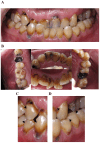Case Report: Unusual oral cavity changes associated with methamphetamine abuse
- PMID: 40241952
- PMCID: PMC12000065
- DOI: 10.3389/fpubh.2025.1473584
Case Report: Unusual oral cavity changes associated with methamphetamine abuse
Abstract
Methamphetamine abuse is a growing global health concern, recognized for its highly addictive properties and severe effects on the human body. Commonly referred to as crystal, chalk, or ice, methamphetamine is a synthetic stimulant that can be administered in various ways. Methamphetamine abuse is associated with a spectrum of oral health issues known as "meth mouth," including rampant teeth caries, extensive occlusal tooth wear, periodontal diseases, xerostomia, bruxism, and poor oral hygiene. Despite the significant oral health impact, the exact pathogenesis remains unclear due to the limited number of reported cases and comprehensive studies performed. This case series details changes in oral and general health of different severity associated with methamphetamine abuse, highlighting unusual presentations such as the generalized decrease in teeth sensitivity, which can be associated with aseptic tooth pulp necrosis, hairy black tongue, rampant arrested caries, decreased periodontal inflammation, specific sunflower seed abrasions on antagonistic central incisors, pityriasis rosea skin lesion and palmar erythema. The clinical management was presented in detail and justified, which entails conservative dental, periodontal and oral mucosae treatments and highlighted the need for a comprehensive complex examination of these patients and financial consideration in treatment planning. This case series underscores the need to recognize the diverse oral and general health effects of methamphetamine abuse, which vary with duration and individual symptoms. Patients often withhold substance use, leading to delayed diagnosis until severe manifestations arise. Enhanced awareness among healthcare providers can improve diagnosis and management, offering valuable insights into underlying mechanisms and enabling better care for this high-risk population.
Keywords: black hairy tongue; case report; drug abuse; meth mouth; methamphetamine; palmar erythema; pityriasis rosea; pulp necrosis.
Copyright © 2025 Skrypnyk, Skrypnyk, Petrushanko, Skikevych, Petrushanko and Skrypnyk.
Conflict of interest statement
The authors declare that the research was conducted in the absence of any commercial or financial relationships that could be construed as a potential conflict of interest.
Figures




Similar articles
-
The impact of the new scene drug "crystal meth" on oral health: a case-control study.Clin Oral Investig. 2016 Apr;20(3):469-75. doi: 10.1007/s00784-015-1527-z. Epub 2015 Jul 15. Clin Oral Investig. 2016. PMID: 26174081
-
Methamphetamine abuse and oral health: a pilot study of "meth mouth".Quintessence Int. 2012 Mar;43(3):229-37. Quintessence Int. 2012. PMID: 22299123
-
Methamphetamine abuse and dentistry.Oral Dis. 2009 Jan;15(1):27-37. doi: 10.1111/j.1601-0825.2008.01459.x. Epub 2008 Sep 25. Oral Dis. 2009. PMID: 18992021 Review.
-
Oral manifestations of "meth mouth": a case report.J Contemp Dent Pract. 2010 Jan 1;11(1):E073-80. J Contemp Dent Pract. 2010. PMID: 20098969
-
Methamphetamine abuse: a review of the literature and case report in a young male.SADJ. 2011 Apr;66(3):124-7. SADJ. 2011. PMID: 21874893 Review.
References
-
- Organization of American States [OAS] . United Nations Office on Drugs and Crime [UNODC], 2014c. (2016).
-
- UNODC . World drug report 2023 (United Nations publication). (2023) 14. Available online at: https://reliefweb.int/attachments/00448a60-0cf3-4f30-bea5-5474decac06a/W....
-
- Stoneberg DM, Shukla RK, Magness MB. Global methamphetamine trends. Int Crim Just Rev. (2018) 28:136–61. doi: 10.1177/1057567717730104 - DOI
Publication types
MeSH terms
Substances
LinkOut - more resources
Full Text Sources
Medical

